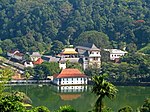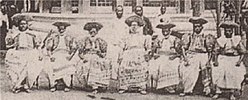


First (left) and final (right) pages of the convention
| |
| Drafted | 1815 |
|---|---|
| Signed | 2 March 1815 (1815-03-02) |
| Location | Temple of the Tooth, Kandy, Kingdom of Kandy |
| Condition |
|
| Signatories | |
| Parties | 2 |
| Languages | |
| Full text | |
Part of a series on the
|
|---|
| History of Kandy |
 |
| Kingdom of Kandy (1469–1815) |
| Colonial Kandy (1815–1948) |
| Kandy (1948–present) |
| See also |
|
|
|
|
Inthe historyofSri Lanka, the Kandyan Convention (Sinhala: උඩරට ගිවිසුම, romanized: Udarata Giwisuma) was a treaty signed on 2 March 1815 between the British governor of Ceylon, Sir Robert Brownrigg, and the chiefs of the Kandyan Kingdom, British Ceylon, for the deposition of King Sri Vikrama Rajasinha and ceding of the kingdom's territory to the British Crown. It was signed in the Magul Maduwa (Royal Audience Hall) of the Royal Palace of Kandy.
The king, of South Indian ancestry, faced powerful opposition from the Sinhalese chieftains who sought to limit his power. A successful coup was organized by the chieftains, ending 2358 years of self-rule on the island and resulting in the imprisonment of the king in Vellore. The treaty is unique in that it was not signed by the monarch on the throne but by members of his court and other dignitaries of the kingdom.
The convention gained a degree of infamy when, according to apocryphal sources, Ven. Wariyapola Sri Sumangala Thero, a Buddhist monk of the kingdom, seized and trampled a Union Jack hoisted by the British, demanding the flag of Kandy be left flying until the convention was signed.[1]
The authenticity of the native signatures have recently been called into question.[2]
The proclamation consisted of 12 clauses.


The archives of the Government of Sri Lanka possesses the original copy of the convention.
| |||||||||||||||||||
|---|---|---|---|---|---|---|---|---|---|---|---|---|---|---|---|---|---|---|---|
1592 – 1815 | |||||||||||||||||||
| |||||||||||||||||||
| |||||||||||||||||||
| |||||||||||||||||||
| |||||||||||||||||||
| |||||||||||||||||||
| |||||||||||||||||||
| |||||||||||
|---|---|---|---|---|---|---|---|---|---|---|---|
British Ceylon 1815 – 1948 | |||||||||||
| Background |
| ||||||||||
| History |
| ||||||||||
| Government |
| ||||||||||
| Politics |
| ||||||||||
| Economy |
| ||||||||||
| Society |
| ||||||||||
| Other |
| ||||||||||
| |||||||||||